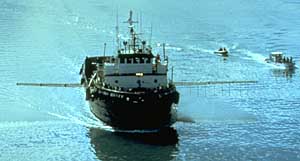|
Introduction to Spill Tools
Spill Tools is a collection of three tools you can use to assess how effectively you can recover, remove, or disperse spilled oil using:
- mechanical equipment, such as skimmers, to remove oil from the sea surface.
- in situ burning, to burn off freshly spilled oil.
- chemical dispersants, to disperse the spilled oil throughout the water column.
Spill Tools was designed to help you to complete tasks like:
- selecting and staging response equipment, such as skimmers, fire boom, and dispersant applicators.
- deploying your equipment as effectively as possible.
- comparing the performance you might get from different kinds of equipment or deployment strategies.
Spill Tools was designed especially for members of Area Committees (defined under the National Oil and Hazardous Substances Pollution Contingency Plan), who need to prepare "local area plans" for responding to potential oil spills in a particular geographic area (such as Puget Sound or San Francisco Bay). Area Committee members can use Spill Tools to find out how to effectively deploy the various response resources available to them, in the event of a spill.
Mechanical Equipment Calculator
You can use the Mechanical Equipment Calculator to estimate the rates at which mechanical equipment, such as skimmers, can recover oil from a specified slick. By adjusting the information you type into the Calculator, you can see how reconfiguring your skimmer operation might affect how quickly you could recover oil.
Dispersant Mission Planner
| You can use the Dispersant Mission Planner to calculate how much dispersant you would need to apply to completely treat a specified amount of oil, given a particular dispersant-to-oil ratio (the photo at right shows dispersant being applied from a vessel). To use the planner, you need estimates of the thickness and area of the oil slick. |  |
In Situ Burn Calculator
You can use the In Situ Burn Calculator to estimate:
- how much fire boom you would need to burn a specified amount of spilled oil or section of an oil slick.
- how many burns you would need to conduct.
- concentrations within the smoke plume that would be generated by the burn.
You can make predictions either for oil already spilled on the water ("batch mode"), or for oil that is continuing to spill ("continuous mode"). In batch mode, the boom encounter rate (the rate at which the boom entraps oil) depends on oil slick thickness, swath width, and tow speed (relative to the water). In continuous mode, the boom encounter rate is estimated from the source release rate, the tow speed, and the speed of the current relative to the source of the oil. For both modes, the In Situ Burn Calculator predicts the performance of one U configuration of fire boom. (A U configuration is a length of fire resistant boom connected to a towing vessel at each end by a bridle.) In batch mode, the calculator predicts the number of burns that would be taken by one U configuration to remove the spilled oil. In continuous mode, the calculator predicts the number of U configurations of a specified length needed to burn the oil as it continues to be released.
Estimating Slick Thickness
All three Spill Tools calculators need an estimate of the thickness of the specified oil slick. To make that estimate, you can use either:
- a thickness estimate from the ADIOS oil weathering model (see the link below for more information about ADIOS).
- your own estimates of the volume of spilled oil and the area it covers (convert both volume and area to the same units, and then divide the volume by the area to estimate the thickness).
- your knowledge of the approximate number of barrels of oil or emulsion per acre of the slick.
For more information
|
- ADIOS2 Learn more about the oil weathering model, ADIOS.
|
|


